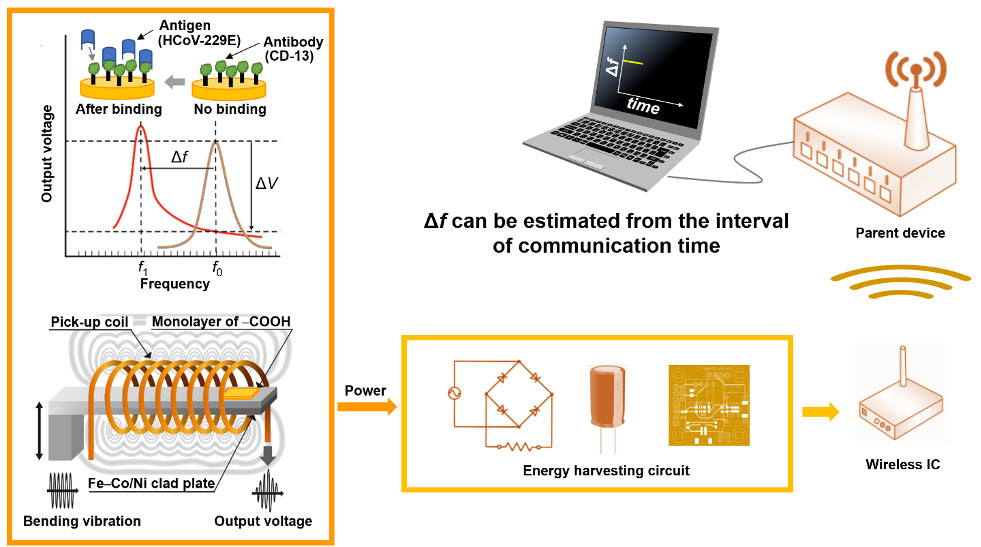| Dec 02, 2022 |
Batteryless and wireless device detects coronavirus with magnetostrictive composite plates
(Nanowerk News) What if you could tell if your surroundings contained COVID-19 particles or droplets the moment they or you entered the vicinity? A collaborative research group has engineered a self-sustaining device that brings this closer to reality (Sensors and Actuators A: Physical, "Battery-less Wireless Magnetostrictive Fe30Co70/Ni Clad Plate for Human Coronavirus 229E Detection").
|
|
The device, which requires no batteries, employs a magnetostrictive clad plate composed of iron, cobalt and nickel, generating power via alternative magnetization caused by vibration. The vibration resonance frequency of the Fe-Co/Ni plates, which were coated with the receptor protein coronaviruses use to enter our cells, changes when the virus is absorbed, alluding to COVID-19 particles being in the air.
|
 |
| A schematic of how the device operates. (Image: Tohoku University) (click on image to enlarge)
|
|
"We know that resonance frequency changes when the weight of a magnetostrictive material changes, but we set out to answer whether this is also the case when a virus is absorbed and if this absorption is detectable," said Fumio Narita, co-author of the study and professor at Tohoku University's Graduate School of Environmental Studies.
|
|
To answer these questions, Fumio and his team first had to create an efficient inverse magnetostrictive sensing system that could operate without batteries and communicate information wirelessly.
|
|
They modified a 0.2mm thick Fe-Co/Ni plate with a rectifier/storage circuit that harvested bending vibration energy and enabled the wireless transmission of information. The plate transmitted signals with the power obtained from bending vibration at 115 Hz or 116 Hz. A change in clad plate weight affected the resonance frequency and altered the transmission intervals, meaning it could detect any substances that adhered to the clad plate.
|
|
Next, the group created the bio recognition layer, choosing to focus on human coronavirus 229E (HCoV-229E) - one of the seven types of coronavirus that affects humans. They immersed the clad plate in a CD13 protein solution and performed sensing experiments. When the coated clad plate was subjected to bending vibration, the resonance frequency decreased after HCoV-229 was absorbed, verifying whether the charged power could transmit virus detection as a signal.
|
|
"We were able to confirm that the magnetostrictive composite material can detect the virus and transmit this detection data using power generated by itself," added Narita. "The self-sustaining nature of the device renders it possible to link it to IoT technologies in the future, something not capable with current biosensors."
|
|
The device could be used on other pathogens with modifications to the bio recognition layer. "In the future, we hope to further develop our device and see if it applies to other viruses, such as MERS, SARS and COVID-19," said Narita.
|

